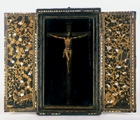Japanese Gallery (Honkan) Room 14
September 2, 2014 (Tue) - November 3, 2014 (Mon)
During the Azuchi-Momoyama period (1573-1603), merchants and Christian missionaries from Spain and Portugal crossed the seas to Japan. The Japanese, who encountered Western culture for the very first time, called these people nanban-jin ("southern barbarians"), but were very receptive to their manners and customs. In fact, a "nanban trend" occurred, with European food and clothing in particular being eagerly adopted by the Japanese. Lacquerware featuring depictions of Europeans as well as folding screens portraying maritime trade also became popular.
The Europeans, in turn, discovered an applied art that was completely new to them - Japanese lacquerware, which has a beautiful black luster and is resistant to both heat and water. They shipped it to Europe in great quantities. It was novel merchandise from the "Far East," made attainable through advances in sailing and navigation, as well as proof of missionary work being carried out in Asia.
As the trend for Orientalism permeated the upper classes in Europe, Japanese lacquerware became extremely popular. To these Europeans, it was a decorative furnishing symbolic of East Asia. In response, lacquerware of new shapes and designs, suited to the lifestyles and preferences of Europeans, and quite different from that traditionally used in Japan, was produced. Displayed here, this "export lacquerware" brims with variety and reflects cultural exchange between the East and the West.

